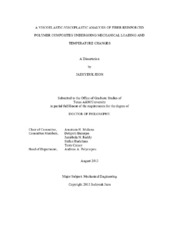| dc.description.abstract | This study presents a combined viscoelastic (VE)-viscoplastic (VP) analysis for Fiber Reinforced Polymer (FRP) composites subject to simultaneous mechanical load and conduction of heat. The studied FRP composites consist of unidirectional fibers, which are considered as linearly elastic with regards to their mechanical response, and isotropic polymeric matrix, which shows viscoelastic-viscoplastic response under various stresses and temperatures. Due to the viscoelastic and viscoplastic behavior of the polymeric matrix, the overall FRP composites exhibit a combined time-dependent and inelastic behavior. A simplified micromechanical model, consisting of a unit-cell with four fiber and matrix subcells, is formulated to homogenize the overall heat conduction and viscoelastic-viscoplastic responses of the FRP composites. The micromechanical model is compatible with a displacement based finite element (FE) and is implemented at the Gaussian integration points within the continuum finite elements, which is useful for analyzing the overall time-dependent response of FRP composite structures under various boundary conditions. The Schapery nonlinear integral model combined with the Perzyna viscoplastic model is used to describe the viscoelastic-viscoplastic response of the polymer constituents. An integrated time integration algorithm is formulated at the micromechanics level in order to solve the nonlinear viscoelastic-viscoplastic constitutive model at the matrix subcells and obtain the overall nonlinear response of the FRP. The viscoelastic-viscoplastic micromechanical model is validated usingexperimental data on off-axis glass/epoxy FRP composites available in literature. The overall response of the FRP composites determined from the simplified micromechanical model is also compared with the ones generated from microstructures of FRP with various fiber arrangements dispersed in homogeneous polymer matrix. The microstructural models of the FRP with detailed fiber arrangements are generated using FE. The effects of thermal stresses, due to the mismatches in the coefficient of thermal expansions of the fibers and polymeric matrix, and stress concentrations/discontinuities near the fiber and matrix interfaces on the overall thermo-mechanical deformation of FRP composites are studied using the two micromechanical models discussed above. Finally, an example of structural analysis is performed on a polymeric smart sandwich composite beam, having FRP skins and polymeric foam core with piezoelectric sensors integrated to the FRP skins, undergoing three point bending at an elevated temperature. The creep displacement is compared to experimental data available in literature. | en |


